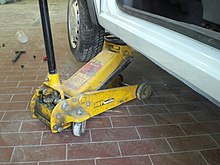Jack
A jack is a machine that is used to lift a motor vehicle and thereby ensure accessibility for repairs and maintenance . The most common use of the jack is to change wheels (e.g. from summer tires to winter tires ).
Jacks are mostly used outside of workshops for flat tires, but also for other breakdowns that make it necessary to lift the vehicle at a low height. In workshops , such activities as changing wheels are usually carried out on a lifting platform or, when working on the underside of the vehicle, in a workshop pit.
Embodiments
Classic designs
- Trolley jack
- Scissor jack ( toggle mechanism, mostly with integrated spindle winch)
Special designs
- Hydraulic jack
- Air cushion jack ("balloon jack")
- Roller jack (description below)
Recovery and lifting equipment
- Rack and pinion winch
- Spindle winch
- High lift jack (vehicle recovery)
use
In jobs where a person must bring himself under the raised by jacking the vehicle, it is necessary that in addition because of the risk of an accident with a jack stand to secure.
The points on a vehicle at which it can be lifted with a jack or a lifting platform are usually described in the vehicle manufacturer's manual . In the case of self-supporting bodies, these points are mainly on the sill under the A and C pillars . However, frame-supporting vehicles are lifted by the frame and in no way by the body. In some cases, there are reinforced wishbones with jack mounts on vans . Control arms that are not intended for this purpose, however, must never be used to lift the vehicle.
Motorsport
In Formula 1 , special jacks ( roller jacks ) are used to change tires on the front and rear axles during pit stops . These jacks are individually made for a special vehicle, but basically have the same mechanical principle in Formula 1. It is comparable to the principle of a hand truck . The support surface is designed for the damage-free lifting of the vehicle. The axes of the jack are designed according to the required force absorption. The bearings and rollers are suitable for heavy loads. The trolley jack is equipped with a long lever arm to enable the car to be lifted quickly and easily . For use on the rear axle, the subframe of the gearbox is the jack point. The jack must be placed centrally between the tires on the axle and must not damage any parts on the underbody.
If the front wing and with it the nose of the vehicle have to be changed, there is nothing left to do but lift the nose by hand so that the vehicle can be supported further back (the jack blocks the exchange process).
Touring cars and DTM cars often have compressed air pistons built into the vehicle floor, which lift the car using externally connected pressure. "Normal" jacks are used in NASCAR races, similar to those used in all workshops. Here it is usually sufficient to change the wheels on one side; these jacks are attached to one side.
Legal position
In Germany there is no obligation to have a jack in the vehicle.
All over Europe, jacks are subject to Directive 2006/42 / EC (Machinery Directive) .
literature
- Dieter K. Franke: VAG manual. Do it yourself. Used car purchase-accessory installation-care. 1st edition, ADAC Verlag, Munich 1984, ISBN 3-87003-227-8 .
Web links
credentials
- ^ René Hofmann: Tire change in two seconds . In: sueddeutsche.de . April 5, 2013, ISSN 0174-4917 ( sueddeutsche.de [accessed December 22, 2017]).
- ↑ Three-Second Intoxication: The Man at the Jack . In: Motorsport-Total.com . ( motorsport-total.com [accessed December 22, 2017]).



